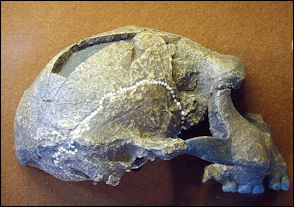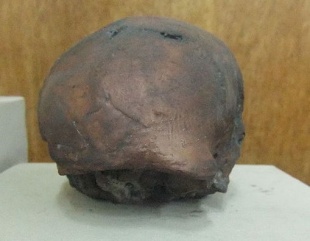HOMO ERECTUS IN INDONESIA
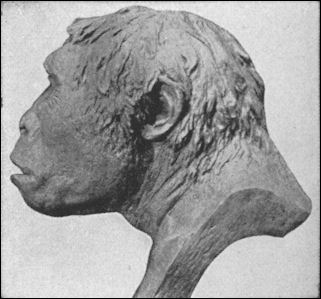
Java Man Indonesia is of crucial importance to the study of human origins and evolution. Sites in central Java, such as Sangiran and Ngandong, now account for about 75 percent of the world’s examples of “homo erectus”, an early hominid type. The main Homo erectus sites in Indonesia are: Sangrian 1.6 to 1 million years ago; Mojokerto, 1.5 million years ago; Trinil (Java Man), 1 million to 700,000 years ago; Ngandong, 117,000 to 108,000 years ago; [Source: Library of Congress *]
Beginning in the 1890s, paleontologists discovered fossil remains of creatures on the island of Java that, while probably not the direct ancestors of modern humans, were closely related to them. These Javan hominids, known by scientists as Homo erectus, lived 500,000 years ago and some possibly as long as 1.7 million years ago. Their remains are identified as Jetis — the earlier specimens found in eastern Java — and Trinil — later specimens found in Central Java, including the Solo River area. Evidence of probable descendants of the Trinil erectus, known as Homo soloensis or Solo Man, was found at Ngandong, also in Central Java; these descendants are thought to have evolved between 500,000 and 100,000 years ago. Assemblages of stone tools have not clearly been tied to Homo soloensis, but there is evidence that these early Homo sapiens had a rudimentary social organization (small hunting and gathering bands) and used simple tools around 40,000 years ago. *
Many observers agree that the modern inhabitants of Indonesia may be descended from Homo erectus. Although insufficient paleographical information makes it impossible to determine precisely the dates of migrations by modern Homo sapiens, contrary to earlier hypotheses of migration from the Malay Peninsula, many experts believe that Indonesia's early population — comprised of the ancestors of most of its present inhabitants — was the product of continued hominid evolution within the archipelago. There was, of course, continuing seepage of other populations into the gene pool, contributing to the complex ethnographic picture of Indonesia. That the archipelago may have developed its own Homo sapiens line has not been ruled out by some scholars. *
H. erectus is believed to be have been the first hominin to have dispersed from Africa, and they spread as far as northern China (Zhoukoudian, Peking Man) and Java. Some researchers thought that H. erectus and modern humans (homo sapiens) lived at the same time and modern humans may have descended from homo erectus. However, based on current dating of homo erectus and modern humans in Java, this theory has largely been dismissed. T is now believed that homo erectus became extinct on Java a little more than 100,000 years ago and the first modern humans arrived in Indonesia around 55,000 years ago or later.
RELATED ARTICLES:
HOMO FLORESIENSIS: HOBBITS OF INDONESIA factsanddetails.com
ORIGINS AND ANCESTORS OF HOMO FLORESIENSIS (HOBBITS) factsanddetails.com
EARLY MODERN HUMANS IN INDONESIA factsanddetails.com
EARLY HUMANS IN SULAWESI, INDONESIA AND THEIR 45,000-YEAR-OLD CAVE ART factsanddetails.com
EARLY HUMANS IN BORNEO: NIAH CAVES 40,000-YEAR-OLD ROCK ART factsanddetails.com
EAST TIMOR — HOME OF THE WORLD’S FIRST DEEP SEA FISHERMEN factsanddetails.com
EARLIEST PEOPLE OF INDONESIA: NEGRITOS, PROTO-MALAYS, MALAYS AND AUSTRONESIAN SPEAKERS factsanddetails.com
OLDEST CULTURES IN INDONESIA AND PEOPLE THERE BEGINNING 10,000 YEARS AGO factsanddetails.com
Websites and Resources: Modern Human Origins modernhumanorigins.com ; Talk Origins Index talkorigins.org/origins ; Hall of Human Origins American Museum of Natural History amnh.org/exhibitions ; Time Space Chart Hominid Fossils Pictures msu.edu/~heslips ; Smithsonian Human Origins Program humanorigins.si.edu ; Wikipedia article on Human Evolution Wikipedia ; Becoming Human University of Arizona site becominghuman.org ; Human Evolution Images evolution-textbook.org ;Hominid Species talkorigins.org ; Institute of Human Origins iho.asu.edu ; Paleoanthropology Link talkorigins.org ; Britannica Human Evolution britannica.com/EBchecked/topic/275670/human-evolution ;Modern Human Origins modernhumanorigins.com ; Human Evolution handprint.com ; Paleoanthropology and Evolution Links unipv.it/webbio/dfpaleoa ;National Geographic Atlas of the Human Journey genographic.nationalgeographic.com/genographic/atlas ; Yale Peabody Museum peabody.yale.edu/exhibits/fossils ; Human Origins Washington State University wsu.edu/gened/learn-modules ;
RECOMMENDED BOOKS:
“Java Man : How Two Geologists' Dramatic Discoveries Changed Our Understanding of the Evolutionary Path to Modern Humans” by Roger Lewin , Garniss H. Curtis, et al. Amazon.com;
“Ancestral DNA, Human Origins, and Migrations” by Rene J. Herrera (2018) Amazon.com;
“Asian Paleoanthropology: From Africa to China and Beyond” (Vertebrate Paleobiology and Paleoanthropology) by Christopher J. Norton and David R. Braun Amazon.com;
“Emergence and Diversity of Modern Human Behavior in Paleolithic Asia” by Yousuke Kaifu, Masami Izuho, et al. Amazon.com;
“Paleoanthropology and Paleolithic Archaeology in the People's Republic of China” by Wu Rukang, John W Olsen Amazon.com;
“In search of Homo erectus: a Prehistoric Investigation: The humans who lived two million years before the Neanderthals” by Christopher Seddon (2017) Amazon.com;
“Peking Man” Amazon.com;
“Liangzhu Culture” by Bin Liu, Ling Qin, et al. Amazon.com;
“A Brief History of Ancient China” by Edward L Shaughnessy Amazon.com
“Processes in Human Evolution: The journey from early hominins to Neanderthals and modern humans” by Francisco J. Ayala, Camilo J. Cela-Conde Amazon.com;
“Evolution: The Human Story” by Alice Roberts (2018) Amazon.com;
“Perspectives on Our Evolution from World Experts” edited by Sergio Almécija (2023) Amazon.com;
“Discovering Us: Fifty Great Discoveries in Human Origins” By Evan Hadingham (2021) Amazon.com;
“Who We Are and How We Got Here: Ancient DNA and the New Science of the Human Past” by David Reich (2019) Amazon.com;
“Stone Tools in Human Evolution”
by John J. Shea (2016) Amazon.com;
“Our Human Story: Where We Come From and How We Evolved” By Louise Humphrey and Chris Stringer, (2018) Amazon.com;
“Lone Survivors: How We Came to Be the Only Humans on Earth” by Chris Stringer (2013) Amazon.com;
“Almost Human: The Astonishing Tale of Homo Naledi and the Discovery That Changed Our Human Story” by Lee Berger, John Hawks, et al. Amazon.com;
“An Introduction to Human Evolutionary Anatomy” by Leslie Aiello and Christopher Dean (1990) Amazon.com;
“Basics in Human Evolution” by Michael P Muehlenbein (Editor) (2015) Amazon.com;
“Sapiens: A Brief History of Humankind” by Yuval Noah Harari (2011) Amazon.com;
Discovery of Java Man
Java man was discovered by Eugene DuBois, a young Dutch military doctor, who came to Java in 1887 with the sole purpose of finding the "missing link" between humans and apes after hearing about discoveries of ancient human bones (which later turned out to belong to modern man) near the Javanese village of Wajak, near Tulung Agung, in eastern Java.
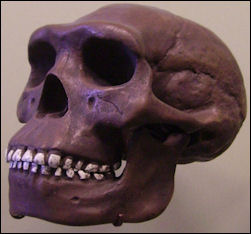
Java Man skull With the help of 50 East Indian convict laborers, he discovered a skull cap and thighbone — that clearly didn't belong to an ape — along the banks of the Sunngai Bengawan Solo River in 1891. After measuring the cranial capacity of the skull with mustard seeds, Dubois realized that the creature was more of an "ape-like man" than a "man-like ape." Dubois dubbed the find “Pithecanthropus erectus”, or "upright ape-man,” which is now regarded as an example of “Homo erectus”.
The discovery of Java Man was the first major hominid find, and helped launch the study of early man. His finding created such a storm of controversy that Dubois felt compelled to re-bury the bones for 30 years to protect them.
DuBois was the student of Ernst Haeckel, a Charles Darwin disciple who wrote “History of Natural Creation” (1947), which advocated the Darwinian view of evolution and speculated about primitive human beings. Dubois came to Indonesia with the ambition of confirming Haekel’s theories. He died a bitter man because his discoveries he felt weren't taken seriously.
After Dubois other Homo erectus bones were unearthed in Java. In the 1930s, Ralph von Koenigswald found fossils, dated at be 1 million years old, near the village of Sangiran, along the Solo river, 15 kilometers north of Solo. Other fossils have been found along the Sungai Bengawan Solo in Central and East Java and near Pacitan in East Java’s south coast. In 1936 a skull of a child was found at Perning neat Mojokerto.
Homo Erectus
“Homo erectus” had a considerably larger brain than “Homo habilis”, its predecessor. It fashioned more advanced tools (double-edged, teardrop-shaped "hand axes" and "cleavers" ) and controlled fire (based on the discovery of charcoal with erectus fossils). Better foraging and hunting skills, allowed it to exploit its environment better than “Homo habilis” Nickname: Peking Man, Java Man. “Homo erectus” lived for 1.3 million years and spread from Africa to Europe and Asia. Paleontologist Alan Walker told National Geographic, “Homo erectus “ "was the velociraptor of its day. If you could look one in the eyes, you wouldn't want to. It might appear to be human, but you wouldn't connect. You'd be prey."
Geologic Age 2 million years to 100,000 years ago. Homo erectus “ lived at the same time as “Homo habilis “ and “Homo rudolfensis” and later at the same time as Neanderthals and modern humans, but not necessarily in the same places. Linkage to Modern Man: Regarded as a direct ancestor of modern man, May have had primitive language skills. Discovery Sites: Africa and Asia. Homo erectus“ fossils have been found in eastern Africa, southern Africa, Georgia, Algeria, Morocco, China and Java.
Size: The tallest hominin species until modern man. The body looked almost like a modern human. males: 1.78 meters (5 feet 10 inches) tall, 139 pounds (63 kilograms) females: 1.6 meters (5 feet 3 inches) tall, 53 kilograms (117 pounds). “Homo erectus” was considerably larger than its forebears. Scientists speculate that the reason for this is that they ate more meat. Brain Size: 800 to 1000 cubic centimeters. Enlarged over the years from the size of a one -year-old infant to that of a 14-year-old boy (about three-fourths the size of a modern adult human brain). A 1.2-million-year-old skull from Olduvai Gorge had a cranial capacity of 1,000 cubic centimeters, compared to 1,350 cubic centimeters for a modern human and 390 cubic centimeters for a chimp.
See Separate Article: HOMO ERECTUS: factsanddetails.com
Prehistoric Indonesia
Indonesia consists of parts of the Sunda Shelf, extending from mainland Asia and forming the world’s largest submerged continental shelf; a deep-water channel charting what is known as Wallace’s Line roughly running between the islands of Kalimantan and Sulawesi, and between the islands of Bali and Lombok; and parts of the Sahul Shelf, an extension of Australia. Despite arcs of frequent volcanic activity and patterns of rising and falling sea levels, this has been a favored region for modern humans and their hominid predecessors for nearly 2 million years. [Source: Library of Congress *]
About 800,000 years ago, some early hominids of the archipelago made stone tools, constructed water craft sophisticated enough to cross 25 kilometers of rough sea channel, and may have used fire and language. About 600,000 years ago, a fairly sophisticated hominid culture was widely distributed throughout what is now Indonesia. The earliest modern humans cannot currently be firmly dated before about 40,000 years ago, but some specialists argue either that they appeared much earlier (as much as 90,000 years ago) in a rapid dispersal from Africa, or that they evolved independently in East or Southeast Asia from existing hominid stock. Whatever the case, Indonesia’s earliest modern humans did not immediately or everywhere displace their hominid relatives but coexisted with them for tens of thousands of years. The earliest modes of their existence show little evidence of having deviated markedly from those of their predecessors. A pattern evolved of small hunting-fishing-foraging communities depending on tools made of shell, wood, bamboo, and stone, adapting to a wide variety of ecological niches and remaining in contact with neighboring peoples over land and sea. *
The earliest inhabitants of Indonesia are believed to have been Homo erectus (See Below). The 2004 announcement of discoveries on the island of Flores (between Bali and Timor) created international controversy because they suggested an entirely new, locally evolved, and distinctively smaller hominid form overlapping chronologically with both “homo erectus”and modern humans.
Redating Java Man
In 1994, Berkeley scientist Carl Swisher shook up the paleontology world when he redated the volcanic sediments of the Indonesian “Homo erectus” skull (See Mojokerto Child Below) using a sophisticated mass spectrometer — that accurately measure the radioactive decay rates of potassium and argon found in volcanic sediments — and found that the skull was 1.8 million years old instead of 1 million years old as was previously reported. His discovery placed “Homo erectus” in Indonesia, some 800,000 years before it was thought to have left Africa. Critics of Swisher's findings say that the skull may have been washed into older sediments. In response his critics Swisher has dated numerous sediment samples taken where hominid fossils were found in Indonesia and found that most of the sediments were 1.6 million years old or older.
Homo erectus bones were redated again, by an Indonesian-Japanese team, in the late 2010s and found to be not as old as previously thought. The new estimate, published in the journal Science, dated Homo erectus fossils in the Sangiran dome by around 1.3 million years old, and no older than 1.5 million years old. That’s at least 300,000 years younger than Swisher’s 1.8 million year old figure from the 1990s — a date that was always controversial because other studies came come up with much younger estimates for Homo erectus at Sangiran, ranging from 1.3 to 0.6 million years old. [Source: Dyani Lewis, Cosmos, January 9, 2020]
Dyani Lewis wrote in Cosmos: To figure out whether the fossils were older or younger, Shuji Matsu’ura from the National Museum of Nature and Science in Tsukuba City, Japan, and colleagues used two separate dating techniques not previously used at the site. “It was exciting to know which chronology would be supported by the new method,” says Masayuk Hyodo from Kobe University, a senior author on the study.
Uranium-lead dating, which measures the crystallisation age, and fission track dating, which measures the volcano eruption age, of zircon grains show that volcanic ash just below the fossil-bearing layers are just 1.3 million years old. “The combination of uranium-lead and fission track is a really nice combination,” says Kira Westaway, who led a study revising the youngest erectus remains on Java. It’s dating two different events, so if you get an agreement between the two, then you really know that you’re onto something,” she says.
The younger age of first appearance at Sangiran fits with other remains on Java that have been dated to 1.49 million years old. It also puts to bed ideas that the birthplace of Homo erectus could have been in Southeast Asia. It now seems much more likely that Homo erectus arose in Africa and dispersed out through Georgia in the Caucasus, where the oldest Homo erectus remains aged 1.85 million years old have been found. From there, they dispersed into Asia. “People say, ‘well, it’s only a few hundred thousand years, who cares?’ But it really is a big deal,” says Westaway.
Homo Erectus Fossils from Indonesia
More Homo erectus fossils have been found in Indonesia than anywhere else in the world. They include the "Java Man" (Trinil 2 skullcap, Trinil 3 femur, and an associated tooth), various specimens from Sangiran (such as Sangiran 17), and the Ngandong series (also called the Solo series), which includes Ngandong 1, 5, 6, and 10. Other important fossils were found at sites like Ngawi, Sambungmacan, Mojokerto and the Madura Strait. [Source: Google AI]
Trinil Site (Java Man)
Trinil 2: The first major find, a skullcap discovered in 1891, which became the holotype for Pithecanthropus erectus (later classified as Homo erectus).
Trinil 3: A thigh bone found in 1892 that indicated an upright, human-like posture.
Trinil 1: An isolated tooth found at the site.
Sangiran Site
Sangiran 17: A skull specimen dating to around 800,000 years ago.
Bpg 2001.04: A partial maxilla (upper jawbone) dating to about 1.5 million years ago, making it one of the oldest specimens from Sangiran.
Other specimens include S4, S27, and Tjg 1993.05.
Ngandong and Sambungmacan Sites
The Ngandong series (also known as the Solo series) consists of 11 fossil crania and two tibiae found along the Solo River.
Ngandong 10: A skull from the Ngandong series, dated to between 136,000 and 106,000 years ago.
Ngandong 1 (Solo 1), Ngandong 5 (Solo 4), and Ngandong 6 (Solo 5): Other fossils from the Ngandong series.
Sambungmacan fossils: While initially thought to be from the same period as Ngandong, they are now considered to be from a different time, according to J-Stage.
Ngawi Site
Ngawi 1: A calvaria (skullcap) from the Ngawi region, which has been compared to the Ngandong and Sambungmacan fossils.
Madura Strait (Surabaya Strait)
Recent discoveries during dredging operations have yielded Homo erectus fossils from the seabed of the Madura Strait, an area that was once part of the ancient landmass of Sundaland.
Sangiran and Trinil: Home of Java Man
Sangiran (16 kilometers from Solo in Central Java) is near where the skull of "Java Man" was found. A small museum is dedicated to the ancient fossil. The story of Java Man begins over a century ago. In 1890, when Eugene Dubois, a Dutch military physician and paleontologist discovered a fossilized primate jawbone at Trinil further east down the Solo river. This jawbone possessed distinctly human characteristics. Dubois was convinced that this was Darwin’s “missing link” in the evolution of man but lacked the evidence to prove his theory. Nearly 50 years later, Berlin-born paleontologist G H R von Koenigswald, unearthed the fossilized ‘Java Man’, homo erectus jawbone in Sangiran, which has been dated to be 1.8 million years old and is regarded as one of the most important fossils ever found..
Skull from Sangiran It’s believed that Java man probably made his home in caves or in open camps and it’s likely that he was the first hominin that used fire. He also used stone axes and hand-adzes, most of which were discovered by the Baksoka River near Pacitan.The Sangiran area is rich in fossils of all types.
According to UNESCO: “Sangiran is one of the key sites for the understanding of human evolution. It illustrates the development of Homo sapiens sapiens from the Lower Pleistocene to the present through the outstanding fossil and artefactual material that it has produced. The archaeological site of Sangiran is situated 15 kilometers east of Solo. The geological stratigraphy of the Sangiran area covers 2 million years, from the late Pliocene to the recent periods. The Lower and Middle Pleistocene Ievels have produced considerable fossil and artefactual material. Fifty early human fossils (Pithecanthropus erectus/Homo erectus ) have been found, representing 50 percent of all the known hominid fossils in the world, together with numerous animal and floral fossils such as rhinoceros, elephant ivory, buffalo horn, deer horn and many others.
See Sangrian Under CENTRAL JAVA : factsanddetails.com
Homo Erectus Fossils at Sangiran
Named after a village near Solo, in central Java, Sangiran is the most important Homo erectus site in Indonesia, and arguably the world. The remains of over 80 individuals, including 10 partial crania and 14 mandibular and maxillary (jaw and face) specimens, have been found here at a number of locations. Fossils were first collected from this site under Ralph von Koenigswald, by local village between 1936 and 1940 and after 1950 by farmers and Indonesian researchers. The fossil collected under von Koenigswald are held in the Senckenberg Forschungsintitut in Frankfurt, Germany, with the post WWII collections held at the GRDC in Bandung and Gadjah Mada University, Yogyakarta. [Source: Peter Brown, palaeoanthropology.net
Peter Brown wrote in palaeoanthropology.net: Fossil hominin bearing formations of the Sangiran dome are the Sangiran formation and the overlying Bapang formation. These two formations are separated by a fossil-rich layer, which used to be called the Grenzbank zone. While the stratigraphic integrity and dating of the hominin fossils remains somewhat problematic, the oldest fossils apparently derive from the top of the Sangiran formation. However, most of the hominin fossils come from the younger Bapang formation. Based on Argon-Argon dating the Sangiran formation dates to the period 1.92-1.58 million years ago and Bapang 1.58-1.0 million years ago. The Notuporo formation that caps the Bapang, and has an Argon-Argon date of 780,000 is currently without hominin fossils, so the geologically youngest fossils at Sangiran may be approximately 1 million years ago in age.
The first partial cranium of H. erectus (Sangiran 2) was discovered in 1937, with Sangiran 4 (partial cranium with palate and most of the maxillary teeth) found in 1939. The most complete specimen so far discovered is Sangiran 17,discovered in 1969, and this is curated at the GRDC. All of the Sangiran hominin fossils are now allocated to Homo erectus. With an endocranial volume of 1029-1125 cubic centimters, Sangiran shares a distinctive set of anatomical features with the other Javan H. erectus from Sangiran, Ngandong and Sambungmacan. The cranial vault is long and low, with a receeding frontal bone. The ridge above the eye sockets form a relatively straight and thickened bar, which is particularly thickened laterally. The frontal bone has a median ridge and the bone surface is raised and thickened near the bregma. There is marked postorbital constriction and the superior temporal lines are pronounced and relatively high on the sides of the vault. Maximum cranial breadth is located on the supramastoid crests.
While the cranial vault bone is thickened, it differs from the pattern in H. sapiens, primarily with thickened bone in the lateral cranial walls and in the cranial base. There is a pronounced occipital torus and rugose areas of neck muscle attachment. The orbits are deep and relatively circular in shape, and the nasal aperture does not appear to have been very broad. The most distinctive aspect of the face is in the extremely deep, thickened and strengthened, preserved right zygomatic bone (bones that protrude laterally and form the prominence of the cheeks) .The inferior margin of this bone merges directly with the tooth row. Areas of masticatory muscle attachment and structural reinforcement suggest an adaptation for forceful chewing, however, the maxillary teeth are surprisingly small and with minimal occulsal wear for a hunter gatherer. The Sangiran mandibles also combine thickened tooth bearing segments (corpus and alveolar bone), with surprisingly small teeth.
Mojokerto Child and Its Controversial Dating
The Mojokerto child—also known as Mojokerto 1 and Perning 1—is the fossilized skullcap of a juvenile early human. It was discovered in February 1936 near Mojokerto in East Java, Indonesia, by a member of a team led by Ralph von Koenigswald. Initially classified as Pithecanthropus modjokertensis and later Homo modjokertensis, the specimen is now recognized as Homo erectus. [Source: Wikipedia]
Long considered the most controversial early human fossil from Indonesia, the Mojokerto skull has been at the center of disputes over both its age and its precise findspot. Originally thought to be younger than 1.0 million years, it was re-dated in 1994 using the then-new argon–argon method, which yielded an age of roughly 1.81 million years. The authors of that study, Carl C. Swisher III and Garniss Curtis, argued that such an early date would have major implications for early human migrations “Out of Africa.” Subsequent archival and geological work in the early 2000s, however, pinpointed the exact sediment layer from which the fossil had been excavated and demonstrated that its earliest possible age is 1.49 million years.
Curtis and Swisher III applied argon–argon dating to “hornblende grains from volcanic pumice that appeared to match the filling of the skull.” Guided to the site in 1990 by Indonesian paleoanthropologist Teuku Jacob, they proposed of age 1.8 million years published in Science in 1994, drew enormous attention—appearing in more than 200 newspapers worldwide, including the front page of The New York Times, and sparking cover stories in Discover, New Scientist, and Time.
The claim was fiercely debated. If correct, it would place the Mojokerto child among the oldest known Homo erectus specimens—comparable in age to African Homo ergaster—and would imply that early humans left Africa far earlier than previously believed, or perhaps even originated in Southeast Asia. Few critics doubted the dating technique itself; instead, they questioned whether the pumice sampled for dating actually came from the correct geological layer, given the uncertainties surrounding the original excavation site.
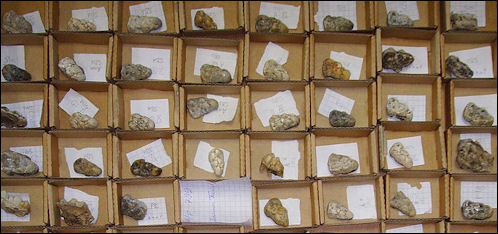
-Fossil teeth of Indonesian pigs at Java Man site
A 2003 study led by archaeologist Mike Morwood used fission-track dating of single zircon grains to propose 1.49 ± 0.13 million years as the maximum age of the fossil. Morwood argued that Curtis and Swisher had sampled pumice from a layer roughly 20 meters below the horizon associated with the skull. The sediment immediately beneath the fossil—“Pumice Horizon 5”—dated to 1.49 million years ago, while the layer directly above—“Pumice Horizon 6”—dated to 1.43 million years ago, In 2006, Australian archaeologist Frank Huffman, drawing on 1930s photographs and field notes, identified the exact excavation site and confirmed that the skullcap indeed lay between these two horizons. The Morwood–Huffman chronology is now widely accepted.
Hominids Cross the Wallace Line
Stone flake tools, found near a stegodons (ancient elephant), dated to 840,000 years ago, were found in the Soa Basin on Indonesian island of Flores. The tools are thought to have belonged to Homo Erectus. They only way to get the island is by boat, through sometimes turbulent seas, which implies “Homo erectus” built seaworthy rafts or some other kind of vessel. This discovery is regarded with caution but may mean that early hominids may have cross the Wallace Line 650,000 years earlier than previously thought.
During several ice ages when sea levels dropped Indonesia was connected to the Asian continent. It is believed that Homo erectus arrived in Indonesia during one of the ice ages.
The Wallace Line is an invisible biological barrier described by and named after the British naturalist Alfred Russell Wallace. Running along the water between the Indonesia islands of Bali and Lombok and between Borneo and Sulawesi, it separates the species found in Australia, New Guinea and the eastern islands of Indonesia from those found in western Indonesia, the Philippines and the Southeast Asia.
Because of the Wallace Line Asian animals such as elephants, orangutans and tigers never ventured further east than Bali, and Australian animals such as kangaroos, emus, cassowaries, wallabies and cockatoos never made it to Asia. Animals from both continents are found in some parts of Indonesia.
The first people to cross the Wallace line from Bali to Lombok, Indonesia, scientists speculate, arrived in a kind of paradise free of predators and competitors. Crustaceans and mollusks could be collected from tidal flats and pygmy elephants unafraid of man could be easily hunted. When food supplies ran low, the early inhabitants moved on to the next island, and the next until the finally reached Australia.
The discovery of the Hobbits in Flores is thought to confirm that Homo Erectus crossed the Wallace Line. See Hobbits.
See Separate Article: HOMO FLORESIENSIS: HOBBITS OF INDONESIA factsanddetails.com ; ORIGINS AND ANCESTORS OF HOMO FLORESIENSIS (HOBBITS) factsanddetails.com
Homo Erectus Roamed Sunderland 140,000 Years Ago
Homo erectus marked a significant shift in human evolution—they were the earliest hominids to bear more of a resemblance to modern humans, with larger bodies, longer legs, and shorter arms relative to their torso. More muscle mass meant that they could walk and run faster than earlier hominins, and were likely more adept hunters. An increase in body size is also associated with an increase in brain size, and skulls tell us that their brains were over 50% larger than those of early Australopithecus species (though the human brain would eventually evolve to be 40% larger than that by the time Homo sapiens appeared [Source: Carly Cassella, ScienceAlert, May 27, 2025; Elizabeth Rayne, Popular Mechanics, May 22, 2025]
Dredging for an artificial island off Java in the mid 2020s uncovered more than 6,700 vertebrate fossils — including two fragments of a Homo erectus skull — offering the first evidence these hominids once lived on the now-submerged plains between Indonesia’s islands. Until now, H. erectus fossils in the region had been found only on Java, leading researchers to assume the species was long isolated there.
Research published in in Quaternary Environments and Humans in May 2025 show that during a glacial period around 140,000 years ago, when sea levels were more than 100 meters lower, the islands of Sundaland, including Java, Bali, Sumatra and Borneo, were connected by vast land bridges resembling an African-style savannah. These lowland plains hosted hippos, crocodiles, rhinos, Komodo dragons, elephants, bovids, and now-extinct fauna — and provided ideal habitat for early humans.
The fossils came from a drowned river valley filled over time with river sands. Evidence of butchery — cut marks on river turtle bones and broken bovid bones for marrow extraction — indicates that H. erectus hunted both aquatic and terrestrial animals. These behaviors mirror those of more modern human species elsewhere in Asia, raising the possibility of cultural contact or even genetic exchange with groups such as Denisovans or Neanderthals, which may have reached the region via the same land bridges. The discoveries also align with earlier evidence from Java that H. erectus used mussel shells as tools and engraved them — the oldest known human engravings — showing the species’ adaptability within riverine environments.

The bones were dredged from between a small and narrow strait separating two islands. Sunderland is the largest drowned shelf in the world. It is now a shallow sea, but in the past was a large chunk of land as well as a land bridge. The underwater fossil trove provides an unprecedented glimpse into a once-connected world where Homo erectus moved freely across Sundaland, exploiting its rivers and rich ecosystems. When sea levels rose again, these landscapes vanished beneath the sea, leaving their record buried until now. Scientists believe that more answers may still lie on the seafloor, awaiting future discovery.
Solo Man, Ngandong and the Last Homo Erectus
Research appears to indicate that the last place homo erectus survived was on of Java. Archaeology magazine reported: A team used new technology on previously excavated remains to confirm that 12 H. erectus skulls from Ngandong were between 117,000 and 108,000 years old, making them the last known members of their species. [Source: Archaeology magazine, March -April 2020]
At first the Homo erectus fossils found at Ngandong were thought to be between 100,000 and 300,000 years old. Then it was reported the fossils were found strata dated between 27,000 and 57,000 years old. This implied that “Homo erectus” lived much. much longer than anyone thought and “Homo erectus” and “Homo sapiens” existed at the same time on Java. Many scientists were skeptical about the 27,000-to-57,000-years-old Ngandong dates and they were ultimately tossed.
Solo Man (Homo erectus soloensis) is the subspecies of H. erectus that lived along the Solo River at Ngandong 117,000 to 108,000 years ago. It is known from 14 skullcaps, two tibiae, and a piece of the pelvis excavated near the village of Ngandong, and possibly three skulls from Sambungmacan and a skull from Ngawi depending on classification. The Ngandong site was first excavated from 1931 to 1933 under the direction of Willem Frederik Florus Oppenoorth, Carel ter Haar, and Gustav Heinrich Ralph von Koenigswald. [Source: Wikipedia]
The Solo Man skull is oval-shaped in top view, with heavy brows, inflated cheekbones, and a prominent bar of bone wrapping around the back. The brain volume was quite large, ranging from 1,013 to 1,251 cubic centimeters (61.8 to 76.3 cubic inche), compared to an average of 1,270 cubic centimeters (78 cubic inches) for present-day modern males and 1,130 cubic centimeters (69 cubic inches) for present-day modern females. One potentially female specimen may have been 158 centimeters (5 ft 2 inches) tall and weighed 51 kilograms (112 pound); males were probably much bigger than females. Solo Man was in many ways similar to the Java Man (H. e. erectus) that had earlier inhabited Java, but was far less archaic.
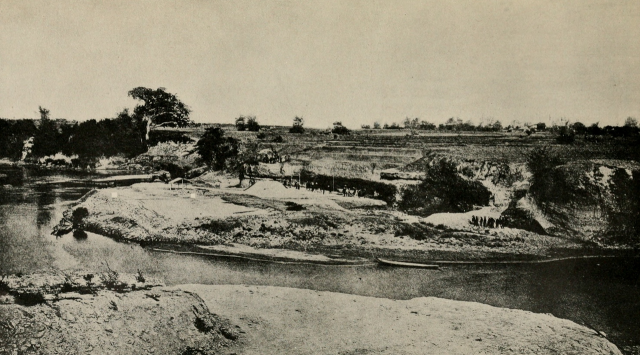
Where the Java Man homo erectus fossils where found on the Bengavian River, Near Trinal, Java; the two small white squares show where the femur (on left) and the skullcap (on right and more behind) were discovered
Solo Man likely inhabited an open woodland environment much cooler than present-day Java, along with elephants, tigers, wild cattle, water buffalo, tapirs, and hippopotamuses, among other megafauna. They manufactured simple flakes and choppers (hand-held stone tools), and possibly spears or harpoons from bones, daggers from stingray stingers, as well as bolas or hammerstones from andesite. They may have descended from or were at least closely related to Java Man. The Ngandong specimens likely died during a volcanic eruption. The species probably went extinct with the takeover of tropical rainforest and loss of preferred habitat, beginning by 125,000 years ago. The skulls sustained damage, but it is unclear if it resulted from an assault, cannibalism, the volcanic eruption, or the fossilisation process.
Image Sources: Wikimedia Commons
Text Sources: New York Times, Washington Post, Los Angeles Times, Times of London, Lonely Planet Guides, Library of Congress, Ministry of Tourism, Republic of Indonesia, Compton’s Encyclopedia, The Guardian, National Geographic, Smithsonian magazine, The New Yorker, Time, Newsweek, Reuters, AP, AFP, Wall Street Journal, The Atlantic Monthly, The Economist, Foreign Policy, Wikipedia, BBC, CNN, and various books, websites and other publications.
Last updated December 2025



